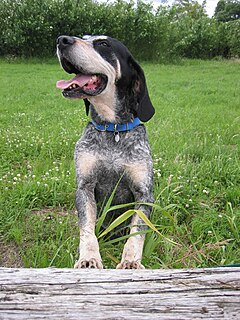
Dumfriesshire Black and Tan Foxhounds were a pack of foxhounds kennelled at Glenholm Kennels, Kettleholm, near Lockerbie until they were disbanded in 2001. They were established by Sir John Buchanan Jardine, author of Hounds of the World (1937), [1] after the First World War. The hounds are believed to have originally been created by crossing Bloodhound/Gascony blue/English Foxhound. They were larger than standard foxhounds and were black and tan. Although that pack was disbanded in 1986, there is a pack descended from them in France, known as Equipage de la Roirie, and they are used also by the Equipage Pique Avant Nivernais as staghounds along with the Français Blanc et Noir hound.

A foxhound is a type of large hunting hound bred for strong hunting instincts, great energy, and, like all scent hounds, a keen sense of smell. In fox hunting, the foxhound's namesake, packs of foxhounds track quarry, followed—usually on horseback—by the hunters, sometimes for several miles at a stretch; moreover, foxhounds also sometimes guard sheep and houses.

Lockerbie is a town in Dumfries and Galloway, south-western Scotland. It lies approximately 75 miles (121 km) from Glasgow, and 20 miles (32 km) from the English border. It had a population of 4,009 at the 2001 census. The town came to international attention in December 1988 when the wreckage of Pan Am Flight 103 crashed there following a terrorist bomb attack aboard the flight.
The Jardine, later Buchanan-Jardine Baronetcy, of Castle Milk in the County of Dumfries, is a title in the Baronetage of the United Kingdom. It was created on 20 July 1885 for the businessman and Liberal politician Robert Jardine. He was head of Jardine, Matheson and Co, merchants in China, and also represented Ashburton, Dumfries and Dumfriesshire in Parliament. Jardine married Margaret, daughter of John Buchanan Hamilton and sister and heiress of John Hamilton-Buchanan, Chief of Clan Buchanan. The second and third Baronets were also heads of Jardine, Matheson and Co. The latter assumed the additional surname of Buchanan.
These large hounds were also crossed with the Dumfriesshire Otterhounds during the foundation of the Otterhound pack. [2] Since the Second World War, the Dumfriessire Hound has been used to improve speed and agility in several clean boot hunting Bloodhound packs; as one example, Eric Furness introduced Dumfriesshire Hound blood into his Peak Bloodhounds. [3]

The Otterhound is an old British dog breed. It is a scent hound and is currently recognised by the Kennel Club as a Vulnerable Native Breed with around 600 animals worldwide.
Dumfriesshire foxhounds starred as bloodhounds in The Thirty Nine Steps with Robert Powell, which was partly filmed in the Kettleholm area.

The Thirty Nine Steps is a British 1978 thriller film directed by Don Sharp, with screenplay by British playwright Michael Robson, based on the novel The Thirty-Nine Steps by John Buchan. It was the third film version of the 1915 novel.










